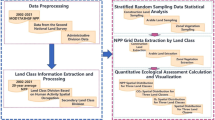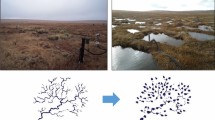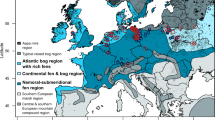Abstract
Revegetation of degraded ecosystems provides opportunities for carbon sequestration and bioenergy production1,2. However, vegetation expansion in water-limited areas creates potentially conflicting demands for water between the ecosystem and humans3. Current understanding of these competing demands is still limited4. Here, we study the semi-arid Loess Plateau in China, where the ‘Grain to Green’ large-scale revegetation programme has been in operation since 1999. As expected, we found that the new planting has caused both net primary productivity (NPP) and evapotranspiration (ET) to increase. Also the increase of ET has induced a significant (p < 0.001) decrease in the ratio of river runoff to annual precipitation across hydrological catchments. From currently revegetated areas and human water demand, we estimate a threshold of NPP of 400 ± 5 g C m−2 yr−1 above which the population will suffer water shortages. NPP in this region is found to be already close to this limit. The threshold of NPP could change by −36% in the worst case of climate drying and high human withdrawals, to +43% in the best case. Our results develop a new conceptual framework to determine the critical carbon sequestration that is sustainable in terms of both ecological and socio-economic resource demands in a coupled anthropogenic–biological system.
This is a preview of subscription content, access via your institution
Access options
Subscribe to this journal
Receive 12 print issues and online access
$209.00 per year
only $17.42 per issue
Buy this article
- Purchase on Springer Link
- Instant access to full article PDF
Prices may be subject to local taxes which are calculated during checkout



Similar content being viewed by others
References
Lal, R. Potential of desertification control to sequester carbon and mitigate the greenhouse effect. Climatic Change 51, 35–72 (2001).
Lal, R. Carbon sequestration in dryland ecosystems. Environ. Manage. 33, 528–544 (2003).
Menz, M. H. M., Dixon, K. W. & Hobbs, R. J. Hurdles and opportunities for landscape-scale restoration. Science 339, 526–527 (2013).
Jackson, R. B. et al. Trading water for carbon with biological carbon sequestration. Science 310, 1944–1947 (2005).
Liu, J. G., Li, S. X., Ouyang, Z. Y., Tam, C. & Chen, X. D. Ecological and socioeconomic effects of China’s policies for ecosystem services. Proc. Natl Acad. Sci. USA 105, 9477–9482 (2008).
Ciais, P. et al. in Climate Change 2013: The Physical Science Basis (eds Stocker, T. F. et al.) Ch. 6 (IPCC, Cambridge Univ. Press, 2013).
Quiggin, J. Environmental economics and the Murray–Darling River system. Aust. J. Agric. Resour. Econ. 45, 67–94 (2001).
Wang, S. et al. Reduced sediment transport in the Yellow River due to anthropogenic changes. Nature Geosci. 9, 38–41 (2016).
Chen, Y. et al. Balancing green and grain trade. Nature Geosci. 8, 739–741 (2015).
Farley, K. A., Jobbágy, E. G. & Jackson, R. B. Effects of afforestation on water yield: a global synthesis with implications for policy. Glob. Change Biol. 11, 1565–1576 (2005).
Zhao, M. F., Xiang, W. H., Peng, C. H. & Tian, D. L. Simulating age-related changes in carbon storage and allocation in a Chinese fir plantation growing in southern China using the 3-PG model. Forest Ecol. Manag. 257, 1520–1531 (2009).
Croft, H., Chen, J. M. & Noland, T. L. Stand age effects on Boreal forest physiology using a long time-series of satellite data. Forest Ecol. Manag. 328, 202–208 (2014).
Gates, J., Scanlon, B., Mu, X. & Zhang, L. Impacts of soil conservation on groundwater recharge in the semi-arid Loess Plateau, China. Hydrogeol. J. 19, 865–875 (2011).
Xu, X. Z., Zhang, H. W. & Zhang, O. Development of check-dam systems in gullies on the Loess plateau, China. Environ. Sci. Policy 7, 79–86 (2004).
Zhang, X., Zhang, L., Zhao, J., Rustomji, P. & Hairsine, P. Responses of streamflow to changes in climate and land use/cover in the Loess Plateau, China. Wat. Resour. Res. 44, W00A07 (2008).
Liang, W. et al. Quantifying the impacts of climate change and ecological restoration on streamflow changes based on a Budyko hydrological model in China’s Loess Plateau. Wat. Resour. Res. 51, 6500–6519 (2015).
Qian, Z. Y. & Zhang, G. D. Comprehensive Report on China’s Sustainable Water Resources Strategy [in Chinese] (China’s Water Conservancy and Hydropower Press, 2001).
Drake, B. G., Gonzàlez-Meler, M. A. & Long, S. P. More efficient plants: a consequence of rising atmospheric CO2? Annu. Rev. Plant Biol. 48, 609–639 (1997).
Wullschleger, S. D., Tschaplinski, T. J. & Norby, R. J. Plant water relations at elevated CO2—implications for water-limited environments. Plant Cell Environ. 25, 319–331 (2002).
Donohue, R. J., Roderich, M. L., McVicar, T. R. & Farquhar, G. D. Impact of CO2 fertilization on maximum foliage cover across the globe’s warm, arid environment. Geophys. Res. Lett. 40, 3031–3035 (2013).
McVicar, T. R. et al. Development a decision support tool for China’s re-vegetation program: simulating regional impacts of afforestation on average annual streamflow in the Loess Plateau. Forest Ecol. Manag. 251, 65–81 (2007).
Mu, X. M., Zhang, L., McVicar, T. R., Chille, B. S. & Gao, P. Estimating the impact of conservation measures on stream-flow regime in catchments of the Loess Plateau. Hydrol. Process. 21, 2124–2134 (2007).
Rose, S. K. et al. Land-based mitigation in climate stabilization. Energy Econ. 34, 365–380 (2012).
McVicar, T. R. et al. Parsimoniously modeling perennial vegetation suitability and identifying priority areas to support China’s re-vegetation program in the Loess Plateau: matching model complexity to data availability. Forest Ecol. Manag. 259, 1277–1290 (2010).
Rodà, F., Retana, J., Gracia, C. A. & Bellot, J. Ecology of Mediterranean Evergreen Oak Forests (Springer, 1999).
Budyko, M. I. Climate and Life (Academic, 1974).
Liu, Q. & McVicar, T. R. Assessing climate change induced modification of Penman potential evaporation and runoff sensitivity in a large water-limited basin. J. Hydrol. 464, 352–362 (2012).
McVicar, T. R. et al. Spatially distributing monthly reference evapotranspiration and pan evaporation considering topographic influences. J. Hydrol. 338, 196–220 (2007).
Zhao, X. et al. The Global Land Surface Satellite (GLASS) remote sensing data processing system and products. Remote Sens. 5, 2436–2450 (2013).
Feng, X. M., Fu, B. J., Lu, N., Zeng, Y. & Wu, B. F. How ecological restoration alters ecosystem services: an analysis of carbon sequestration in China’s Loess Plateau. Sci. Rep. 3, 2846 (2013).
Wu, B. F. et al. Validation of ETWatch using field measurements at diverse landscapes: a case study in Hai Basin of China. J. Hydrol. 436–437, 67–80 (2012).
Chen, X. D. Hydrology of Yellow River Basin [in Chinese] (Yellow River Water Conservancy Press, 1996).
Chen, H. S., Shao, M. A. & Li, Y. Y. Soil desiccation in the Loess Plateau of China. Geoderma 143, 91–100 (2008).
Sitch, S. et al. Evaluation of ecosystem dynamics, plant geography and terrestrial carbon cycling in the LPJ dynamic global vegetation model. Glob. Change Biol. 9, 161–185 (2003).
Hickler, T. et al. Using a generalized vegetation model to simulate vegetation dynamics in northeastern USA. Ecology 85, 519–530 (2004).
Krinner, G. et al. A dynamic global vegetation model for studies of the coupled atmosphere-biosphere system. Glob. Biogeochem. Cycles 19, GB1015 (2005).
Lawrence, D. M. et al. Parameterization improvements and functional and structural advances in version 4 of the community land model. J. Adv. Model. Earth Syst. 3, M03001 (2011).
Tan, K. et al. Application of the ORCHIDEE global vegetation model to evaluate biomass and soil carbon stocks of Qinghai-Tibetan grasslands. Glob. Biogeochem. Cycles 24, GB1013 (2010).
Tao, F. & Zhang, Z. Dynamic responses of terrestrial ecosystems structure and function to climate change in China. J. Hydrometeorol. 12, 371–393 (2011).
Peng, S. Global Change Impacts on Forest Ecosystems in East Asia (Peking University, 2012).
Peng, S. et al. Precipitation amount, seasonality and frequency regulate carbon cycling of a semi-arid grassland ecosystem in Inner Mongolia, China: a modeling analysis. Agric. For. Meteorol. 178, 46–55 (2013).
Piao, S. et al. Evaluation of terrestrial carbon cycle models for their response to climate variability and to CO2 trends. Glob. Change Biol. 19, 2117–2132 (2013).
Lucht, W. et al. Climatic control of the high-latitude vegetation greening trend and Pinatubo effect. Science 296, 1687–1689 (2002).
Piao, S. et al. Effect of climate and CO2 changes on the greening of the Northern Hemisphere over the past two decades. Geophys. Res. Lett. 33, L23402 (2006).
Mao, J. et al. Global latitudinal-asymmetric vegetation growth trends and their driving mechanisms: 1982–2009. Remote Sens. 5, 1484–1497 (2013).
Piao, S. L. et al. Climate and land use changes have a larger direct impact than rising CO2 on global river runoff trends. Proc. Natl Acad. Sci. USA 104, 15242–15247 (2007).
Shi, X., Mao, J., Thornton, P. E., Hoffman, F. M. & Post, W. M. The impact of climate, CO2, nitrogen deposition and land use change on simulated contemporary global river flow. Geophys. Res. Lett. 38, L08704 (2011).
Piao, S. L. et al. Detection and attribution of vegetation greening trend in China over the last 30 years. Glob. Change Biol. 21, 1601–1609 (2015).
Meinshausen, M. et al. The RCP greenhouse gas concentrations and their extensions from 1765 to 2300. Climatic Change 109, 213–241 (2011).
Taylor, K. E., Stouffer, R. J. & Meehl, G. A. An overview of CMIP5 and the experiment design. Bull. Am. Meteorol. Soc. 93, 485–498 (2012).
Acknowledgements
We thank F. Zhou for providing river runoff data from the hydrological catchments. This study was supported by the National Natural Science Foundation of China (nos 41390464 and 41230745), Chinese Academy of Sciences (GJHZ 1502) and the Major Programme of High Resolution Earth Observation System (30-Y30B13-9003-14/16-02). The GLDAS LSM data used were acquired as part of the mission of NASA’s Earth Science Division and archived and distributed by the Goddard Earth Sciences (GES) Data and Information Services Center (DISC).
Author information
Authors and Affiliations
Contributions
B.F., X.F. and S.P. designed the research. X.F., S.P., B.F., S.W. and P.C. wrote the manuscript. S.P., Z.Z., X.F. and Y. Li conducted modelling, projection and statistical analysis. Y.Z., X.F. and B.W. conducted the remotely sensed NPP, ET and land-cover analysis. Y. Lü, S.W. and X.J. conducted the analysis of river runoff from the hydrological catchments.
Corresponding author
Ethics declarations
Competing interests
The authors declare no competing financial interests.
Supplementary information
Supplementary Information
Supplementary Information (PDF 1095 kb)
Rights and permissions
About this article
Cite this article
Feng, X., Fu, B., Piao, S. et al. Revegetation in China’s Loess Plateau is approaching sustainable water resource limits. Nature Clim Change 6, 1019–1022 (2016). https://doi.org/10.1038/nclimate3092
Received:
Accepted:
Published:
Issue Date:
DOI: https://doi.org/10.1038/nclimate3092
This article is cited by
-
Irrigation expansion has kept pace with the CO2 fertilization effect on vegetation growth in a typical arid region
Environmental Sciences Europe (2024)
-
Assessing the contribution of ecological restoration projects to ecosystem services values in the Chinese loess plateau
GeoJournal (2024)
-
Increased precipitation over land due to climate feedback of large-scale bioenergy cultivation
Nature Communications (2023)
-
Potential of land-based climate change mitigation strategies on abandoned cropland
Communications Earth & Environment (2023)
-
A Chinese soil conservation dataset preventing soil water erosion from 1992 to 2019
Scientific Data (2023)



